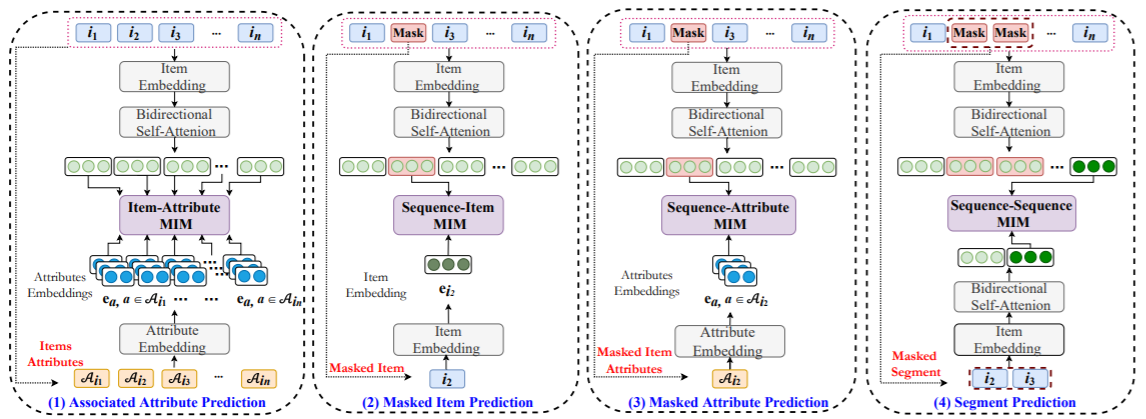S3Rec¶
Introduction¶
Title: S<sup>3</sup>-Rec: Self-Supervised Learning for Sequential Recommendation with Mutual Information Maximization
Authors: Kun Zhou, Hui Wang, Wayne Xin Zhao, Yutao Zhu, Sirui Wang, Fuzheng Zhang, Zhongyuan Wang, Ji-Rong Wen
Abstract: Recently, significant progress has been made in sequential recommendation with deep learning. Existing neural sequential recommendation models usually rely on the item prediction loss to learn model parameters or data representations. However, the model trained with this loss is prone to suffer from data sparsity problem. Since it overemphasizes the final performance, the association or fusion between context data and sequence data has not been well captured and utilized for sequential recommendation. To tackle this problem, we propose the model S<sup>3</sup>-Rec, which stands for Self-Supervised learning for Sequential Recommendation, based on the self-attentive neural architecture. The main idea of our approach is to utilize the intrinsic data correlation to derive self-supervision signals and enhance the data representations via pre-training methods for improving sequential recommendation. For our task, we devise four auxiliary self-supervised objectives to learn the correlations among attribute, item, subsequence, and sequence by utilizing the mutual information maximization (MIM) principle. MIM provides a unified way to characterize the correlation between different types of data, which is particularly suitable in our scenario. Extensive experiments conducted on six real-world datasets demonstrate the superiority of our proposed method over existing state-of-the-art methods, especially when only limited training data is available. Besides, we extend our self-supervised learning method to other recommendation models, which also improve their performance.

Running with RecBole¶
Model Hyper-Parameters:
hidden_size (int): The number of features in the hidden state. It is also the initial embedding size of item. Defaults to64.inner_size (int): The inner hidden size in feed-forward layer. Defaults to256.n_layers (int): The number of transformer layers in transformer encoder. Defaults to2.n_heads (int): The number of attention heads for multi-head attention layer. Defaults to2.hidden_dropout_prob (float): The probability of an element to be zeroed. Defaults to0.5.attn_dropout_prob (float): The probability of an attention score to be zeroed. Defaults to0.5.hidden_act (str): The activation function in feed-forward layer. Defaults to'gelu'. Range in['gelu', 'relu', 'swish', 'tanh', 'sigmoid'].layer_norm_eps (float): a value added to the denominator for numerical stability. Defaults to1e-12.initializer_range (float): The standard deviation for normal initialization. Defaults to0.02.mask_ratio (float): The probability for a item replaced by MASK token. Defaults to0.2.aap_weight (float): The weight for Associated Attribute Prediction loss. Defaults to1.0.mip_weight (float): The weight for Masked Item Prediction loss. Defaults to0.2.map_weight (float): The weight for Masked Attribute Prediction loss. Defaults to1.0.sp_weight (float): The weight for Segment Prediction loss. Defaults to0.5.train_stage (str): The training stage. Defaults to'pretrain'. Range in['pretrain', 'finetune'].item_attribute (str): The item features used as attributes for pre-training. Defaults to'class'for ml-100k dataset.pretrain_epochs (int): The epochs of pre-training. Defaults to ‘500’.save_step (int): Save pre-trained model everysave_steppre-training epochs. Defaults to10.pre_model_path (str): The path of pretrained model. Defaults to''.loss_type (str): The type of loss function. If it set to'CE', the training task is regarded as a multi-classification task and the target item is the ground truth. In this way, negative sampling is not needed. If it set to'BPR', the training task will be optimized in the pair-wise way, which maximize the difference between positive item and negative item. In this way, negative sampling is necessary, such as setting--neg_sampling="{'uniform': 1}". Defaults to'CE'. Range in['BPR', 'CE'].
A Running Example:
Run pre-training. Write the following code to run_pretrain.py
from recbole.quick_start import run_recbole
config_dict = {
'train_stage': 'pretrain',
'save_step': 10,
}
run_recbole(model='S3Rec', dataset='ml-100k',
config_dict=config_dict, saved=False)
And then:
python run_pretrain.py
Run fine-tuning. Write the following code to run_finetune.py
from recbole.quick_start import run_recbole
config_dict = {
'train_stage': 'finetune',
'pre_model_path': './saved/S3Rec-ml-100k-100.pth',
'neg_sampling': None
}
run_recbole(model='S3Rec', dataset='ml-100k',
config_dict=config_dict)
And then:
python run_finetune.py
Notes:
In the pre-training stage, the pre-trained model would be saved every 10 epochs, named as
S3Rec-[dataset_name]-[pretrain_epochs].pth(e.g. S3Rec-ml-100k-100.pth) and saved to./saved/.In the fine-tuning stage, please make sure that the pre-trained model path is existed.
Tuning Hyper Parameters¶
If you want to use HyperTuning to tune hyper parameters of this model, you can copy the following settings and name it as hyper.test.
pretrain_epochs choice [50, 100, 150]
Note that we just provide these hyper parameter ranges for reference only, and we can not guarantee that they are the optimal range of this model.
Then, with the source code of RecBole (you can download it from GitHub), you can run the run_hyper.py to tuning:
python run_hyper.py --model=[model_name] --dataset=[dataset_name] --config_files=[config_files_path] --params_file=hyper.test
For more details about Parameter Tuning, refer to Parameter Tuning.
If you want to change parameters, dataset or evaluation settings, take a look at